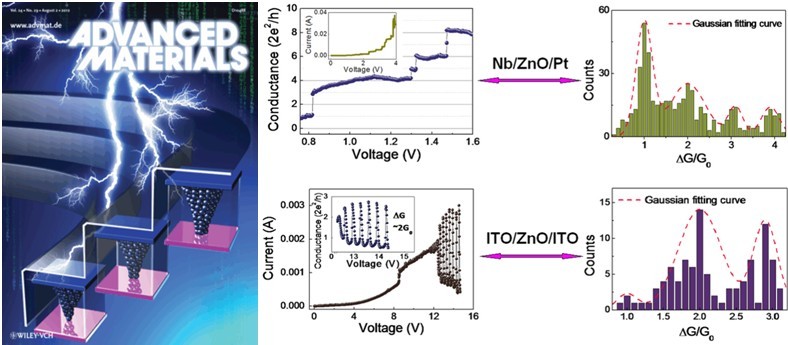Resistive switching (RS) behaviors mainly describe the resistance change phenomena of materials under external electrical modulations. These phenomena can be developed into a new generation nonvolatile resistive random access memory (RRAM) for the data storage. RRAM is considered to be the most competitive candidate against other next-generation memories like ferroelectric random access memory (FeRAM), magnetic random access memory (MRAM) and phase-change random access memory (PRAM) due to its distinct advantages including a simple sandwiched structure, fast data write/erase speed as well as other excellent properties. In general, the RS behaviors can be attributed to the formation/rupture of nanoscale conductive filaments embedded in the materials. This suggests the promising potential for achieving high density storage capacity based on RRAM.
The group of Prof. Runwei Li from Ningbo Institute of Materials Technology & Engineering, Chinese Academy Of Sciences has been doing research in the materials exploration and mechanism studies of RRAMs for years. Invited by the editor of 《Frontiers of Materials Science》, the review “Resistive switching effects in oxide sandwiched structures” including their main works were recently published as the cover story. (http://www.springerlink.com/openurl.asp?genre=article&id=doi:10.1007/s11706-012-0170-8)
Recently, Prof. Runwei Li and his co-workers used superconducting niobium (Nb) as the anode element and fabricated the Nb/ZnO/Pt sandwich structured device, through dedicated design and operation, they observed superconducting behavior of the filaments at low temperatures and also conductance quantization behaviors of the atomic scale filaments at room temperature. They also fabricated the ITO/ZnO/ITO structured devices and observed similar quantum conductance phenomena as well. Furthermore, they proposed some effective methods to precisely modulate the quantum conductance states by controlling the compliance currents and the bias voltages. This finding not only provides guidelines for achieving ultra-high density storage in RRAM, but more importantly, suggests a novel approach to fabricate the manual controllable nano-point contact structures in the solid-state matrixes.
This work was published on materials science magazine Advanced Materials (Adv. Mater. 24, 3941 (2012)) (http://onlinelibrary.wiley.com/doi/10.1002/adma.201201506/pdf) and was selected as the insider cover paper ((http://onlinelibrary.wiley.com/doi/10.1002/adma.201290176/abstract)).

Schematic of the quantum point contacts in the sandwich structures (left) and
quantum conductance phenomena in the Nb/ZnO/Pt and ITO/ZnO/ITO sandwiches (right).

Superconducting behavior of the Nb/ZnO/Pt sandwich (left) and the modulation of quantum contact structure in the ITO/ZnO/ITO device.
Professor Runwei Li runweili@nimte.ac.cn
Research Group Url: http://english.nimte.cas.cn/rh/rd/mmd

